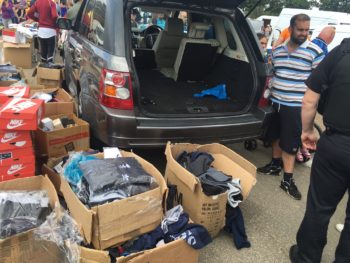
China and Hong Kong are overwhelmingly the largest shipment centres for fake goods sold around the world, in a growing, complex battle against sophisticated counterfeiters, Europe’s police agency said Thursday.
In 2015, the two territories “were the provenance of 86% of global counterfeiting and $396.5bn worth of counterfeit goods,” Europol said in a detailed 74-page report, adding intellectual property theft was “one of the most lucrative criminal enterprises”.
With the rising use of cargo rail links between China and Europe, there are also concerns that criminal networks may begin to seize on what can be a cheaper or faster alternative for transporting goods than container shipping or air links.
Turkey is another important hub for the entry of fake goods into the European Union, along with Thailand and Singapore, said the joint report produced with the Madrid-based EU Intellectual Property Office.
Everything from shampoos, to batteries, electronics and brand-name clothing, toys, medicine and food has been counterfeited and sold, often to unsuspecting customers. There is also a rising trade in fake labels for Europe-based networks producing such goods inside the zone.
But the top category of fake goods seized at the EU’s borders in 2015 was cigarettes — accounting for some 27 percent of some 88,000 cases investigated by customs officials.
As gangs seek to bypass checks and reach consumers quickly and cheaply, rail connections out of China could offer “concrete advantages,” the report warned.
“Intellectual property crime is extensive in the EU and carries very many adverse effects,” warned Europol head, Rob Wainwright.
“It harms our economies, generates enormous illicit profits for organised crime groups, and often causes direct physical harm to citizens in the form of the growing supply of fake health and safety goods.”
Sales of fake clothing and shoes amounted to more than 26 billion euros in lost sales of legitimate goods in Europe, or 9.7 percent of total revenues, causing an estimated 363,000 job losses in this “mirror economy”, the report said.
Many items are now being sold online directly to consumers, allowing counterfeiters to send their goods in small packets which may pass more easily through border checks.
“Counterfeiters often need to produce and ship products quickly, usually in reaction to emerging product trends and demands,” the report said.
While the goods may be produced cheaply, “air freight, despite being fast, is often too expensive” while a shipping container can take up to six weeks to reach its destination.
China is developing both its rail and road infrastructure to reach the eastern EU external borders.
And “cargo trains offering logistics solutions between China and the EU for nearly half the price of air freight, which take approximately half the time of traditional container shipping, would appear a logical choice,” the report said.